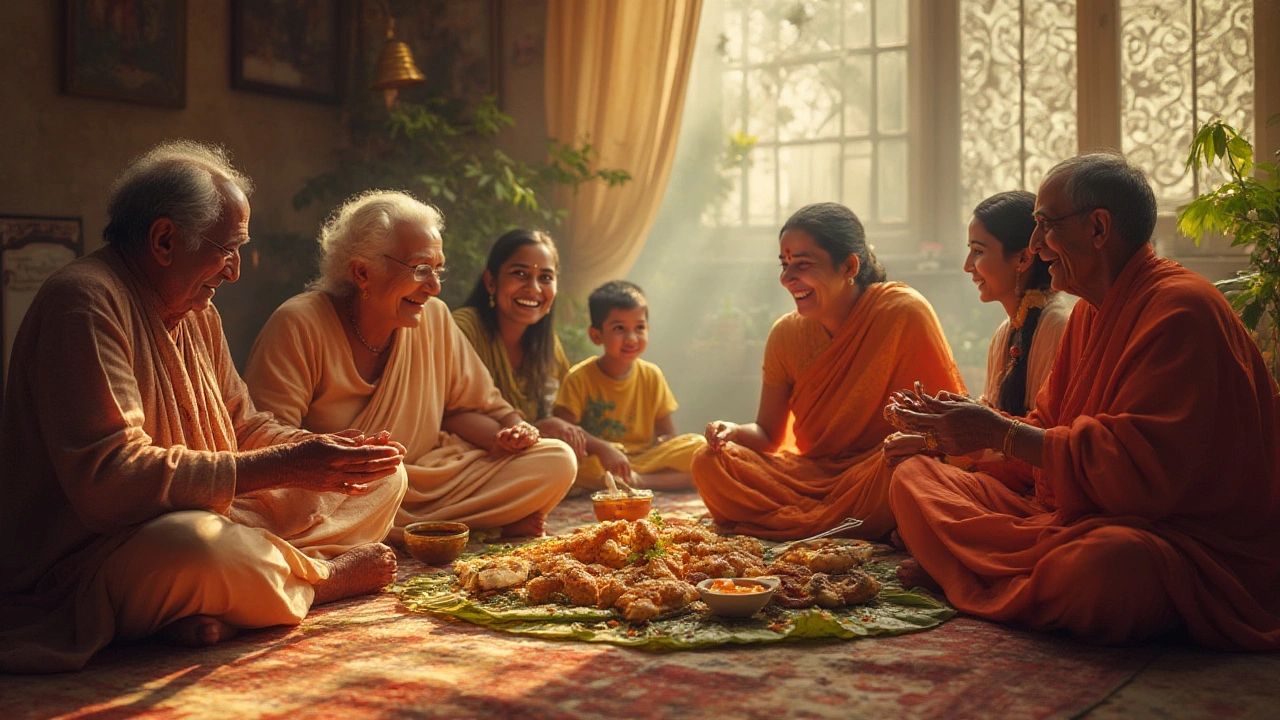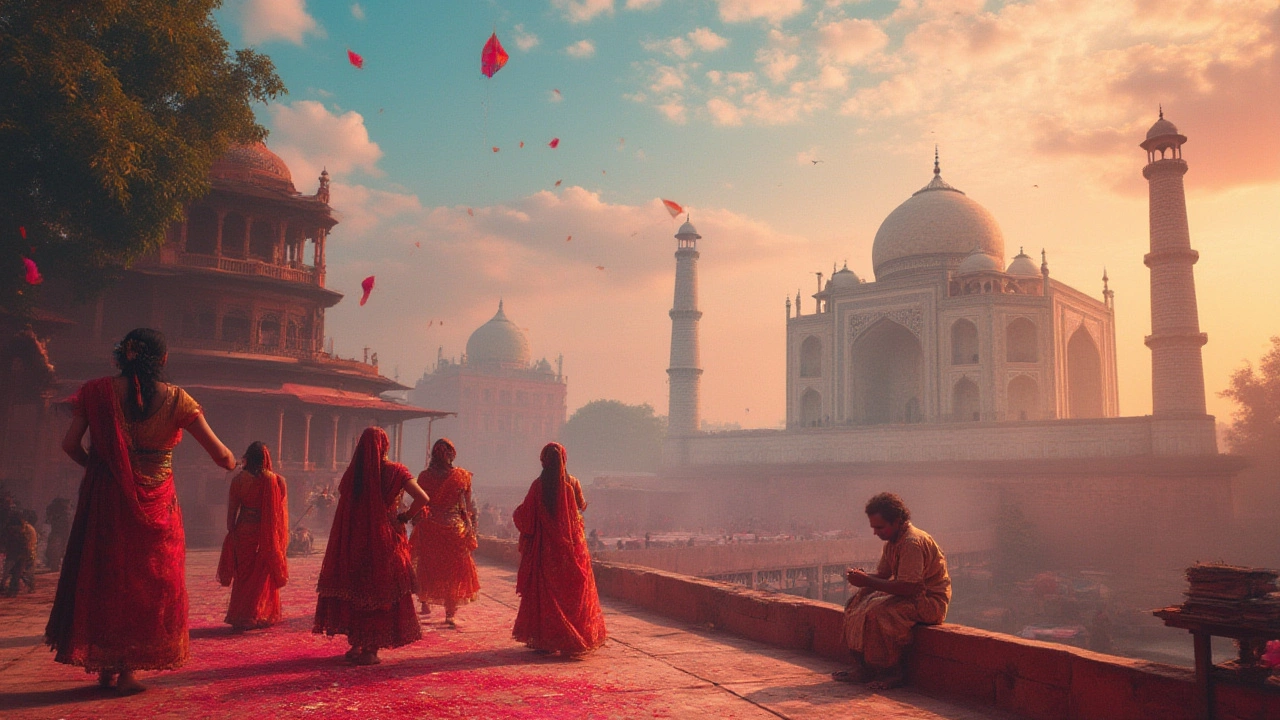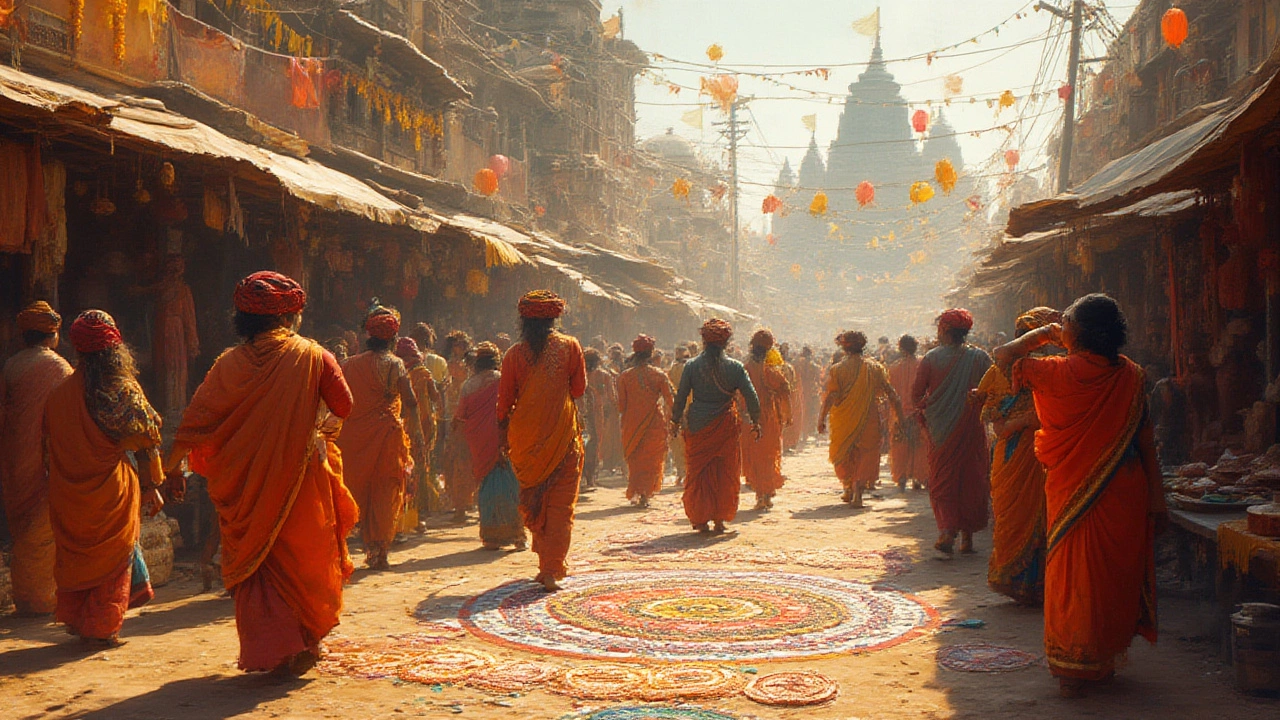It’s impossible to pick just one culture in India and call it the richest—this place simply refuses to fit into a single box. Ask ten people in ten different Indian states, and you’ll get ten wildly different answers. Rather than try to crown a winner, let’s look at how deep, layered, and jaw-droppingly varied Indian culture really is. If you’re ready to be surprised, keep reading, because what you’ll discover might challenge your idea of what "culture" even means.
The Many Flavors of Indian Culture: A Tapestry Across Regions
The first thing everyone notices about India is the explosion of color—on the streets, in the clothes, in the food. But the deeper you look, the more you spot the real richness, woven through languages, rituals, and those small everyday habits that signal where someone’s from. No two neighboring states are exactly alike. Take Kerala with its Onam festivities, snake boat races, and spicy coconut seafood. Now go north to Punjab, where Baisakhi means dancing the bhangra in wheat fields after harvest, and the air fills with the smoky scent of tandoori. Then cross over to West Bengal for Durga Puja, where the entire city of Kolkata comes alive with light displays and pop-up art installations. Even within the same city, you meet Bengalis with a love of fish curry and Rabindranath Tagore, and Marwaris with a knack for business and fascination with elaborate wedding feasts.
India is officially home to 22 major languages, though the real number blows past 1,600 dialects. It’s not unusual for a family in the Northeast to speak three or four languages in the house, switching between tribal dialects, official state languages, and Hindi. Textbook "culture" markers, like saris and curries, barely scratch the surface. Dig a little, and you find distinct architectural styles—Hoysala temples in Karnataka with intricate carvings, wood-and-thatch houses in Nagaland, marble havelis in Rajasthan, colonial bungalows in Goa. Every region shapes the look and feel of daily life. You’ll see it in traditional games (kabaddi in rural Haryana, boat racing in Kerala), in how weddings are celebrated (staid rituals in Tamil Nadu vs. riotous processions in Uttar Pradesh), even in leisure activities like kite flying in Gujarat and pushkar camel fairs in Rajasthan. The sum total? A transcending variety that blows away anyone expecting a single "Indian" culture.
Major Cultures and Their Unmistakable Signatures
If you want to spot which cultures really stand out for their richness, start with a few big names. Tamil culture, for example, stretches back over 2,000 years. It’s given the world the towering Meenakshi Temple at Madurai and poetry that predates much of recorded history. You’ll notice that every Tamil household (no matter where it’s located in the world) starts the day with filter coffee, recites ancient mantras, and celebrates Pongal with rice cooked right in the front yard. Richness, here, isn’t only about old temples—it's about traditions handed down through generations and kept alive in everyday rituals.
Move to Bengal and the story is entirely different, but equally striking. West Bengal’s obsession with literature—Rabindranath Tagore was the first non-European to win the Nobel Prize for Literature—adds a deep vein of intellectual richness. Add to that the riot of art during Durga Puja, the clubs for adda (lively debate over tea), and a cuisine built on river fish and sweets like rasgulla. Northwards, Punjab practically defines community living. Here, culture is loud, open, and joyfully messy. Want to see it in action? Look at a Punjabi wedding or check out the massive community kitchens (langars) at every Sikh gurdwara, where free meals are served to thousands each day, no questions asked.
Or consider Rajasthan—famed for sprawling palaces, mirrored havelis, and a folk tradition that might just be the richest in the country. Desert festivals bring out kalbeliya dancers, camel parades, and musicians with instruments you’ve probably never seen, like the ravanhatta. Rajasthan’s cultural show isn’t just public—it’s embedded in the jewelry, the hand-painted saris, the ceremonial mustaches, and the art of storytelling under the desert sky. Even smaller cultures have their own strengths. Take Kashmir: its Sufi poetry, the craft of Pashmina weaving, and even just the way saffron is grown and served. Or the Manipuri tradition of dance that’s so expressive, UNESCO recognized it as heritage for the whole world.
The secret sauce? Each culture—whether mainstream or niche—finds a way to leave a mark, blending old and new, rigid traditions and daring innovation. You could spend a lifetime exploring and only scratch the surface.

Heritage Sites and Their Cultural Impact
You can’t talk about rich culture in India without mentioning the monumental stuff—literal monuments. The country is dotted with over 40 UNESCO World Heritage Sites, but it’s the local pride and storytelling that transform crumbling stones into living history. Step into Hampi in Karnataka, and you’re walking in the footsteps of the Vijayanagara kings. Locals will tell you about wells built to cool off queens, giant stone chariots that seem poised to roll away, and monkeys that, according to legend, helped build the temples.
Down in Tamil Nadu, the Brihadeeswara Temple wasn’t just an architectural marvel of the 11th century—it’s still at the heart of village life, hosting classical music concerts, weddings, and processions. In the north, the Taj Mahal isn’t just a symbol of romantic love. Ask anyone in Agra, and you'll hear about artisans who, generations down the line, still cut and fit the gleaming marble inlay by hand. The culture isn’t just forged by dead maharajas. It grows through daily rituals, caretaker families who have lived by these sites for centuries, and students who come to learn ancient sculpture, painting, or dance within the temple or fort walls.
Then there’s the Golden Temple in Amritsar, where spiritual life is spun with social outreach and epic round-the-clock cooking—nearly 100,000 meals are served free every single day here. Head east to Sikkim, and you’ll run into peaceful Buddhist monasteries like Rumtek, with daily chants, masked dances, and communal feasts. The architecture and artistry of these places isn’t just about aesthetics: for many villages, it’s their identity, a rallying point for tradition, pride, and even economic sustenance through tourism and crafts.
The big takeaway? Culture in India evolves and endures because it’s embedded into spaces—temples, forts, palaces, and bustling city neighborhoods—carried along by people who see themselves as caretakers, not just as passive observers. If you want to see “rich culture,” don’t just tick off sites on a list—ask locals what the site means to them, and watch history turn alive in their stories.
Living Traditions: Festivals, Food, and Everyday Culture
Nothing captures the heart of Indian culture quite like its festivals. Imagine the color play of Holi, where strangers splash each other with powders as an equalizer, pushing social boundaries aside for one day of pure fun. Check out Diwali, when every home glows with a thousand oil lamps, and even the humblest street in a crowded city feels charged with electricity. Each major Indian festival connects to deep rituals—navratri dances in Gujarat that go all night, Ganesh Chaturthi’s clay idol immersions in Maharashtra, feasts for Eid in Hyderabad, and the grand Christmas processions of Goa.
But let’s talk food—really the crown jewel of Indian culture. The difference between a Bengali fish curry and a Mangalorean one is more than just a spice blend—it’s about generations of culinary wisdom, environmental adaptation, and a sense of identity. You’ll never find one dish that defines "Indian cuisine" because every state, even every street, tweaks flavor profiles, cooking techniques, and ingredients. There’s thali culture—big platters groaning with samples—in Gujarat or Rajasthan, and banana leaf feasts in Kerala. North Indian samosas hardly look or taste like the ones in Calcutta, and street food in Delhi (like spicy chaat and parathas) couldn’t be more different from Mumbai’s vada pav stalls.
Living traditions run even deeper. You’ll notice that the craft of weaving a Kanjivaram saree in Tamil Nadu is passed from mother to daughter, or how mithai recipes are closely guarded secrets among Gujarati sweet shops. In music and dance, every region has its style—Kathak in the north, Bharatnatyam in the south, Odissi on the east coast. Folk theater thrives (like Yakshagana in Karnataka and Tamasha in Maharashtra), traveling from village to village, blending story, song, and satire. Even yoga, now a global trend, has roots in humble Indian ashrams. Ask anyone in Mysore who their grandmother learned their asanas from, and you’ll get stories soaked in history, philosophy, and family pride.
If you want to experience authentic culture, travel during major festivals, wander through farmers’ markets, join a wedding, or just hang around a tea stall at dawn and listen. The magic is in the details of everyday life, where old rituals mix with new trends and create something uniquely Indian.

How to Experience India’s Richest Cultures Firsthand
Diving into Indian culture isn’t just a tourist thing—it’s about getting curious, trying new things, and connecting with locals. If you want to see culture come alive, start with what interests you most. Craving history? Explore Varanasi’s winding ghats—some of the world’s oldest living cities—or Jaipur’s palaces, still run by royal families who host festivals and run museums. If food is your thing, hunt down a local guide and eat at a family-run dhaba in Amritsar or try street snacks at a night market in Hyderabad. Everywhere, there are micro-cultures—fishermen in Kerala with ancient boat-building skills, textile artisans in Kutch spinning bright Bandhani designs, or Qawwali singers in Delhi’s Sufi shrines keeping music traditions alive.
Some practical tips if you want to really dig into culture:
- Learn a few local words—"namaste," "vanakkam," or "sat sri akal" will earn big smiles.
- Time your trip with festivals, but book ahead if you want to join major ones—cultural hotspots fill up fast.
- If inviting, join a family for a festival meal—hospitality runs deep, and almost everyone loves to explain their traditions.
- Check out small town museums, craft fairs, and local parades—they’re often far more personal than giant tourist spots.
- Don’t just photograph monuments—chat with priests, shopkeepers, or musicians. The best stories won’t be on the signboards.
And here’s a wild tip: get off the beaten path. Small villages often hold onto traditional arts, dialects, and rituals long lost in bigger cities. For instance, attend a folk festival in Chhattisgarh, explore the tribal cultures of Nagaland during Hornbill Festival, or try tea-picking with locals in Assam. Curious about crafts? Take a workshop—pottery in Khurja, mat weaving in Kerala, or miniature painting in Jaipur. Many states also have homestay programs now, where you’ll sleep in a local’s home and wake to their routines, making for an immersive experience (and lifelong friends).
You’ll quickly find that India’s richest culture isn’t tucked away in a single spot, region, or community. It lives in the spaces between—shared meals, rituals done publicly and privately, ceremonies kept alive not because they’re profitable, but because they mean something personal. The strongest rich culture India boasts is its ability to reinvent itself while fiercely holding onto what matters. Whether you’re a first-timer or a seasoned traveler, there’s always something fresh waiting—if you’re willing to look a little deeper, listen a little longer, and ask a few more questions.
